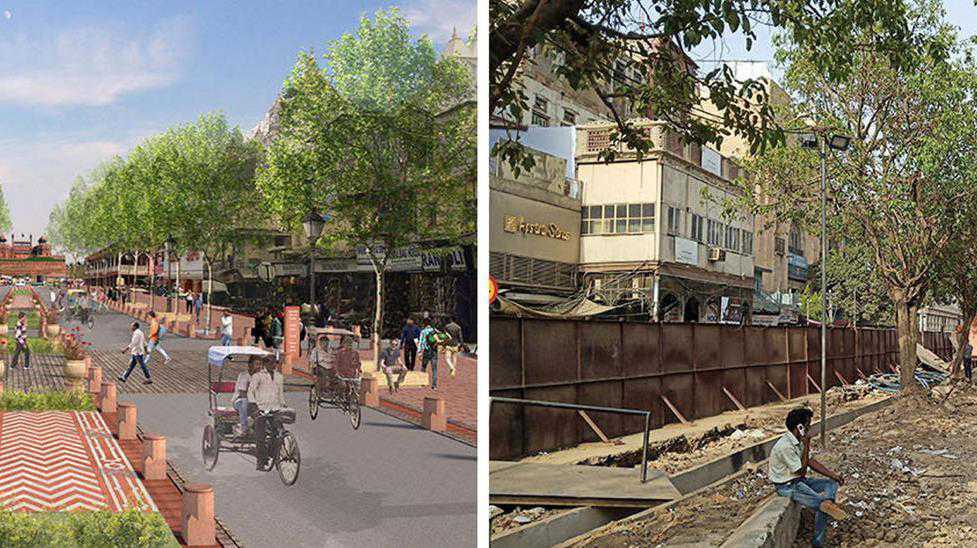From squalid to serene: Old Delhi's famed Chandni Chowk is getting a makeover

Image collected
Outside Mohammed Anwar’s little denim shop is a long tin wall. On the other side of this partition is nothing but noise and filth. The road is dug up, earthmovers rumble around and the deafening sound of digging and drilling – machines and men at work – make conversation impossible. Far from being irritated at the disruption, though, Anwar is thrilled.
“I have lived in this area for 40 years and I have never seen the government doing anything to improve it. This sound and these men,” he says, waving an arm in the direction of the work, “means that, for the first time in decades, the government is doing something for Old Delhi.”
A brief history of Old Delhi, and Chandni Chowk
Old Delhi is the name of the Muslim quarter of the Indian capital. It’s where the great Mughals set up their capital in the 17th century. It was known as Shahjahanabad, after Shah Jahan, who built the colossal Red Fort and the Jama Masjid, one of the largest mosques in India.
Shah Jahan planned the imperial city meticulously, ordering gardens, canals and boulevards to be built, and insisting the shop facades on Chandni Chowk – the massive central vista – should look the same as one another. The city was meant to reflect the glory of the Mughal empire at its height. By rights, the quarter should have been lovingly preserved for its heritage and historical value.
But for decades it has been crumbling. Government after government has neglected it, letting it turn into one gigantic slum. The traffic, noise, pollution, the surging crowds, collapsing edifices, scruffy shops and total squalor are not for the faint-hearted. The sensory overload is enough to damage neurons. The key word is “density” – of people and traffic. Driving a distance of just 300 to 400 metres can take up to an hour.
Anwar has grown up, like other residents, navigating a minefield of broken footpaths, vast tangled clumps of low-hanging electric cables and encroachments by hawkers when he arrives to open his shop every morning. For many decades, there has been no repair or maintenance. The civic authorities have not even so much as moved the electricity lines underground to tidy things up.
The rundown boulevard is now getting a monumental makeover
Yet, change is finally coming to Old Delhi. Chandni Chowk, which starts at the Red Fort and continues for a kilometre down to Fatehpuri Mosque, is being transformed. By early next year, it will be a pedestrianised, tree-lined vista where people can breathe clean air and walk without being constantly jostled.
Shah Jahan’s favourite child, princess Jahanara, originally designed this vast processional avenue. It once had a canal running through it to reflect the moonlight, hence the name Chandni (moon in Hindi) Chowk (market). Once upon a time, shops lined the pavements, as did the mansions of Mughal noblemen and courtiers. Traders came from Central Asia to buy spices and exchange gossip in the coffee houses. Elephants and camels carried produce into the Red Fort, the royal residence.
In many parts of India monuments are routinely neglected owing to a strange absence of respect for history. People in the plushest parts of New Delhi, happily throw their rubbish next to exquisite and ancient tombs
That old grandeur cannot be revived, but the majestic space and proportions of Chandni Chowk are being given fresh life by the New Delhi government, which, after 16 years of endless discussions, has finally asked architect Pradeep Sachdeva to restore the street.
“We took it on because I can’t think of a more challenging project of this nature anywhere in the world,” Sachdeva tells The National. “It’s not just the sheer number of stakeholders in the area, it was also the level of degradation that had taken place over the years. It didn’t seem possible to manage the complex issues in the street.” By this he means cyclists, carts, rickshaws and street vendors, not to mention the sheer number of people and ruin.
Old Delhi's historical importance cannot be overstated
Another reason for taking on such a complex project was the historical importance of it. Old Delhi, or the Walled City as it is also called, was the capital of one of the most powerful and successful dynasties the world has ever seen. At one point, the Mughals ruled 150 million people in an area that covered nearly all of modern India, Pakistan, Bangladesh and Afghanistan. The cultural achievements and opulence of the Mughal court were unparalleled.
When the British took over from the Mughals, they moved their imperial capital from Kolkata to Delhi, but not to the Walled City. Rather, they built their new capital to the south of Old Delhi, where the political and social elite continue to reside to this day.
Source: https://www.thenational.ae
Tags :
Previous Story
- NASA's all-female spacewalk to happen this month
- Growth lessons India can take from new frontrunner...
- Dhaka stocks back in red zone again
- India-Bangladesh discuss trade, investment
- Claw SM 50 headphones review: Building on a...
- Czech Republic will put resources into Bangladesh, inks...
- Bangladesh looks for Nigerian venture
- Bangladesh is booming - and here's why, says...